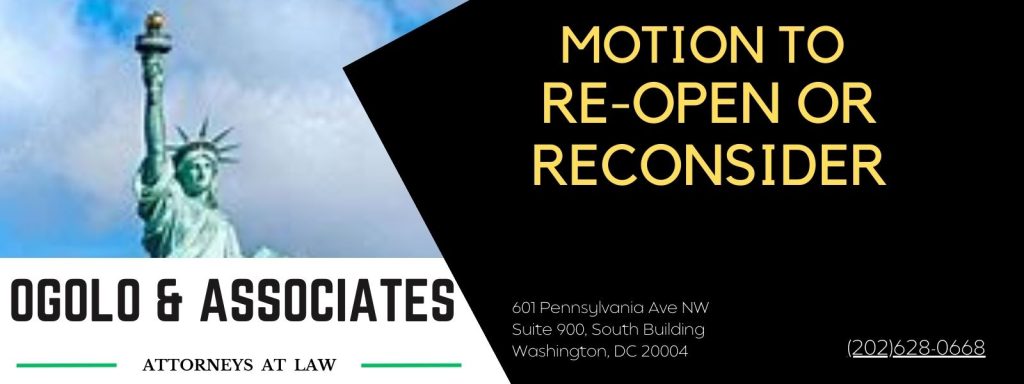You may need to file a motion to re-open and/or reconsider most adverse decisions of the United States Citizenship and Immigration Services, Immigration Court, Administrative Appeals Office and the Board of Immigration Appeals. In most cases, when you receive adverse decision from any of these entities, they will instruct that you may file a motion to re-open and/or motion to reconsider the adverse decision. You may file and address your motion to the USCIS, AAO or the Board. You may also appeal the adverse decision to the Administrative Appeals Office or the Board of Immigration Appeals.
Motion vs. Appeal
In filing a motion to re-open or a motion to reconsider or both, you will address your motion to the entity that issued the adverse decision. If the adverse decision was issued by the USCIS, you will address your motion to the United States Citizenship and Immigration Services. If the adverse decision was issued by the Administrative Appeals Office, you address your motion to that office. Likewise, if the Board of Immigration Appeals issued the adverse decision, you will address your motion to the Board.
If you are asking the same entity that issued the adverse decision to revisit their decision for any reason, you will file your motion to re-open or a motion to reconsider or both to that entity. On the other hand, if you are requesting a higher authority to review the decision of a lesser authority, your request will be by way of appeal, not a motion to re-open or reconsider. The Board of Immigration Appeals is the highest authority compared to the USCIS and Administrative Appeals Office.
If the adverse decision was issued by the USCIS and you wish to appeal that decision, you may file your appeal with the Administrative Appeals Office. or the Board of Immigration Appeals. Likewise, if you received adverse decision from the Immigration Court and you desire to contest that decision, you have to appeal that decision to the Board of Immigration Appeals.
Motion to Re-Open
Motion to re-open is governed by 8 C.F.R. section 103.5. This section specifies how much time you have within which to file your motion from the time the adverse decision was rendered. Basically, you have 30 days from the date of the decision to file your motion. If you received the decision by mail, you are granted 3 more days within which to file your motion. To comply with this requirement, you should endeavor to send your motion to get to its destination within the 30 or 33 days. If your motion gets there after the specified time period, your motion may be dismissed for lateness. Your motion must be filed on Form I290B and may be accompanied by a brief or statement.
The brief or statement must be in writing, and signed by the party filing the motion or by your lawyer. You must also enclose the required filing fee. You are also required to state whether or not the adverse decision is the subject any other judicial proceedings, if so, the court, the nature, date and status or result of the proceedings. The motion must be filed with the same office that issued the adverse decision.
Requirements of s motion to re-open
A motion to re-open must state the new facts to be provided in the re-opened proceedings and be supported by affidavits or other documentary evidence. A motion to re-open an application or petition denied due to abandonment must be filed with evidence that the decision was in error because:
-
The requested evidence was not material to the issue of eligibility’;
-
The required initial evidence was submitted with the application or petition, or the request for initial evidence or additional information or appearance was complied with during the allotted period;
-
The request for additional information or appearance was sent to an address other than that on the application, petition, or notice of representation, or that the applicant or petitioner advised the Service, in writing, of a change of address or change of representation subsequent to filing and before the Service’s request was sent, and the request did not go to the new address.
Motion to reconsider
A motion to reconsider, unlike a motion to re-open does not require proof of new evidence; rather, a motion to reconsider directs the office or officer that issued the adverse decision, to rethink its decision based on evidence already on record – that is, evidence the office already has on file. A motion to reconsider must state the reasons for reconsideration and be supported by any pertinent precedent decisions to establish that the decision was based on an incorrect application of law or Service policy. A motion to reconsider a decision on an application or petition must, when filed, also establish that the decision was incorrect based on the evidence of record at the time the initial decision was made. A motion to reconsider is appropriate where you do not have additional evidence to submit but belief that the original decision was wrong.
Motion to re-open and Reconsider
One may file a combined motion to re-open and a motion to reconsider. However, in considering the combined motion, the reviewing or judicial officer will review each motion separately and consistent with the requirements stated above. The reviewing officer may grant one motion and deny the other, grant both or deny both motions.
